Ah, so much history, culture, magnificent beaches, sunny shores and food to die for! That is what you are looking for when planning your once-in-a-lifetime trip to Spain. The last thing you want is to be bitten by a snake and spending time in a hospital. So, what is the real danger of that happening? Are there snakes in Spain? Where are they? Are they poisonous?
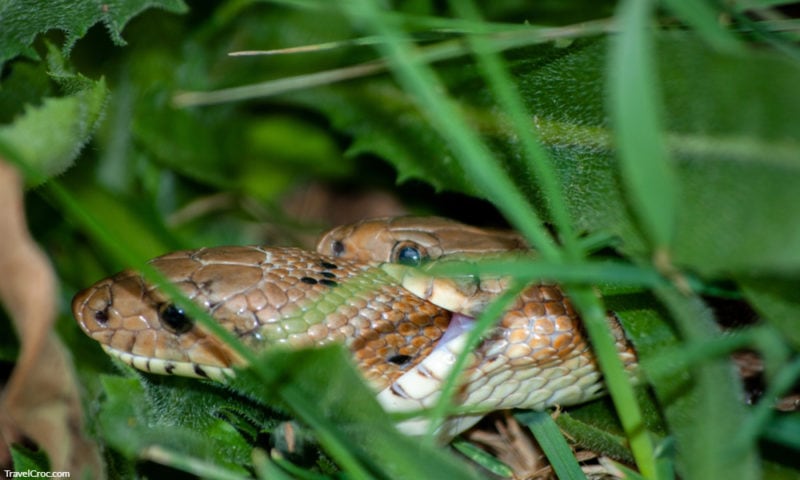
Let’s make it clear: if you are planning on staying in a resort, snakes are not something you have to worry about. But if you plan on exploring the countryside, strolling through sunny hills above the sea or camping in the forest, you need to know what to look for.
Snakes in Spain
There are 12 -15 species of snakes that are commonly found in Spain. Five of them are venomous to humans and their bite requires urgent medical treatment as their venom can be fatal if not treated.
Venomous snakes in Spain
Seoane’s viper (Vipera Seoane)
Vipera seoanei is a venomous snake endemic to southwestern France and northern Spain and Portugal. It is 45-50 cm (18-20 inches) long, reaching a maximum of 75 cm (30 in).
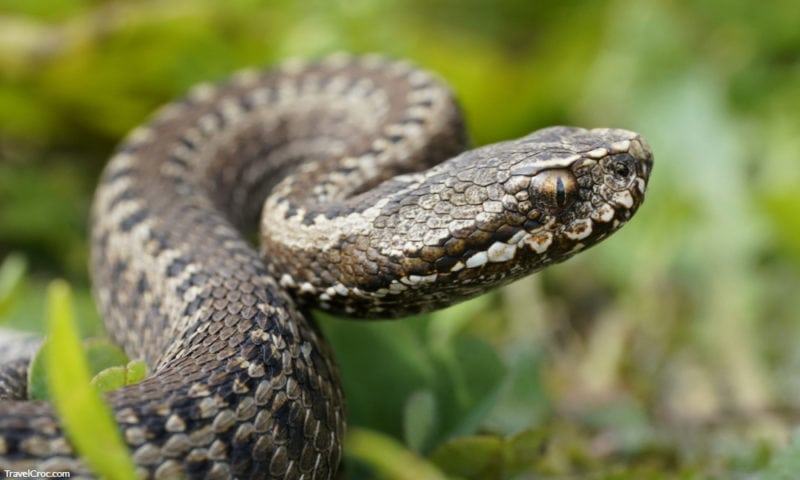
Seoane Viper (Vipera seoanei) defensive position
Locally it is also called the Iberian cross adder or the Baskian viper.
It is not easy to identify them because they can have different patterns: they can have a distinctive zigzag brown pattern on their back with a beige or gray background; other variation is two brown stripes the length of its body the third variation is uniquely brown with no patterns.
These snakes are active from March to the end of October. Seoane’s viper wander in the open and may be active even on cloudy or drizzly days. They are usually spotted basking on a warm rock in sun, but because they are so active can be seen just about anywhere, including cities. The Seoane’s viper feed on small rodents, small birds and lizards.
Seoane’s vipers are the most venomous of all Spanish snakes. Although their venom is not considered life-threatening to healthy adults, it is important to seek medical attention if you are bitten.
False Smooth Snake (Macroprotodon Cucullatus)
Also called the hooded snake, false smooth snake is a mildly venomous snake endemic to the entire Mediterranean area, including Catalonia, northern Spain. It occupies a range of habitats, including near water, rocky areas, sandy shores, pastureland, arable land, and rural gardens.
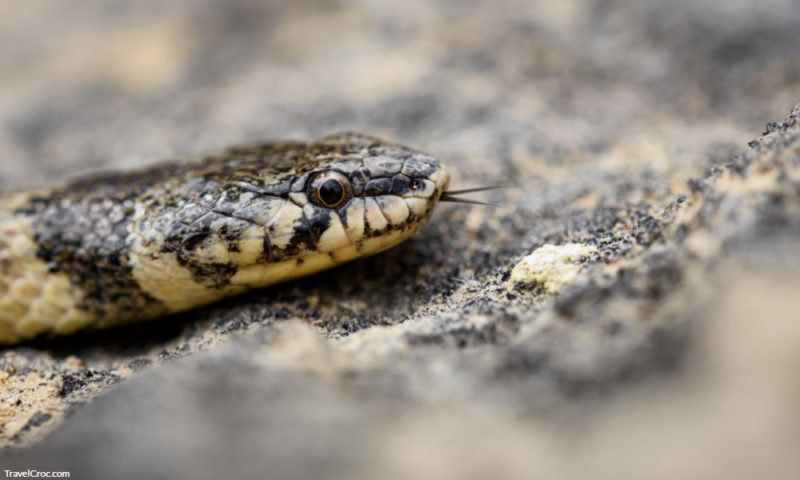
False smooth snake (Macroprotodon brevis)
It is a fairly small snake, not exceeding 55 cm (22 in). Their skin is smooth, tan or gray, with brown spots, or streaks. The stomach is yellow and sometimes coral-red, at times spotted with black.
This snake feeds on small lizards but also nesting birds and small mammals.
While this snake is mildly venomous, because it is so small its bite is not life-threatening to humans but it can be painful. Just in case, see a doctor if bitten to avoid any problems.
Montpellier Snake (Malpolon Monspessulanus)
The Montpellier snake is a mildly venomous snake that grows to about two meters (seven feet) long. It is common in Spain, the Mediterranean coast of France, Portugal and Northwest Africa.
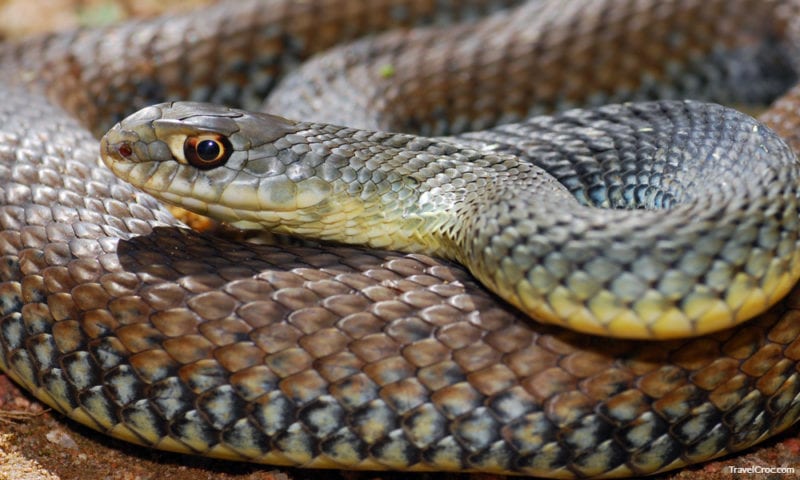
Close up macro shot of a beautifully Montpellier snake, the most common snake in Spain.
It feeds on lizards and is active during the day. Its preferred habitat is heathland and shrubland but also can be seen in grassland, and urban areas.
The Montpellier snake’s scales are metallic, green, brown, gray, or black.
If threatened, this snake raises its head and makes a loud and persistent hissing sound. If you hear that, back off and find another path. They even look aggressive, with a large eye with a prominent ‘brow’ above it.
Because its fangs are in the back, the only way you can get bitten by this snake is if you are handling it. But if it does bite you, it will grab hold and is difficult to dislodge. The symptoms of its venom are numbness, swelling, stiffness, and mild fever but they pass in a few hours.
Viper of Lataste (Vipera Latastei)
Vipera Latastei is a species of venomous snake endemic to the Iberian Peninsula and northwestern Africa.
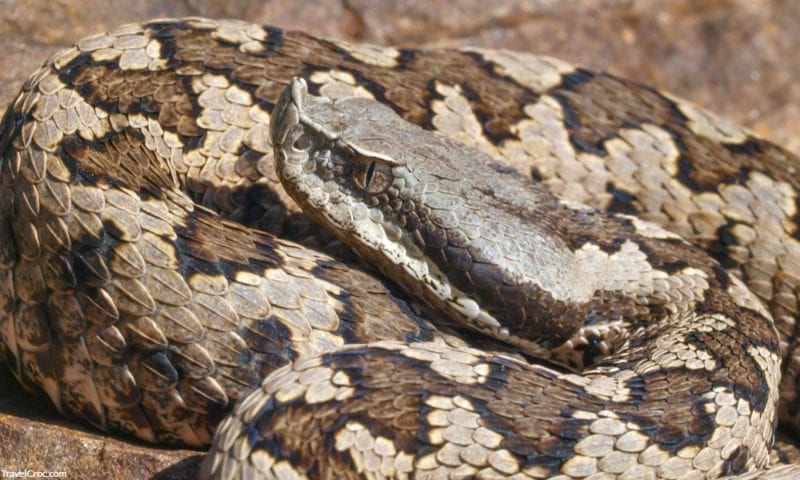
The snup nosed adder (Vipera latastei) on the rocky surface under the sun
It has a triangular head with an upturned snout and a dark-colored band in a zigzag pattern on a brown or grey background. It is short and thick, usually less than 60 cm.
This snake feeds on rodents, chicks, invertebrates and small birds. Its preferred habitats are stony and rocky areas covered in scrub, steep slopes, woodlands and stone walls covered with a bit of vegetation. It is likely to run away if approached.
The venom of Vipera latastei has necrotic effects and can be fatal. The venom contains hemotoxin that disrupts clotting of blood and may cause tissue damage and organ degeneration at the site of the bite. Elderly, children and allergic people are most at risk. If bitten, seek the help of a physician as soon as possible.
Recommended reading:Are There Snakes in Hawaii? Poisonous Snakes in Hawaii
Asp Viper (Vipera Aspis)
Native to southwestern Europe, Asp Viper is a venomous snake that grows to an average length of 60–65 centimeters (24–26 in.) Its head is triangular and broad, with a distinctly upturned nose. Its markings vary greatly from subspecies to subspecies.
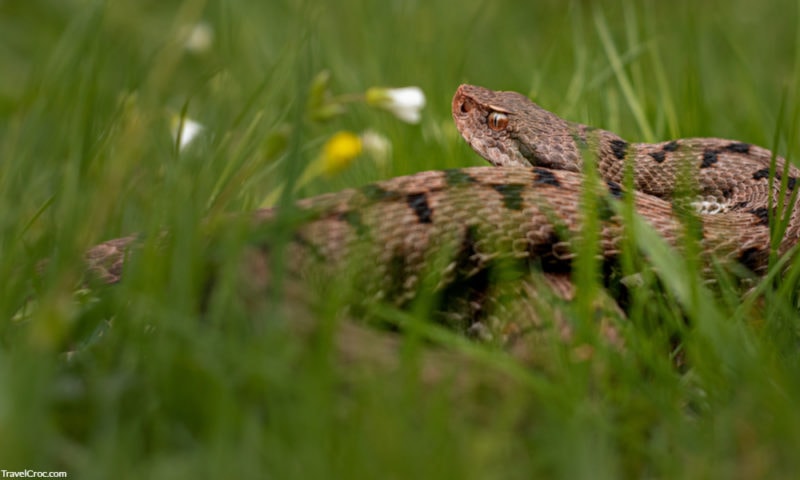
Female asp viper (Vipera aspis francisciredi) in defensive position. It watches the potential danger while laying down.
Asp viper is found in low mountains or hills, especially in limestone regions, but at times in lower plains as well. It prefers vegetated areas or at least a bit of cover. It can be seen on sunny slopes, in glades, on scrublands, in mountain meadows, in forest clearings, in stone quarries and rubbish dumps.
This is one of the most dangerous snakes in Spain. About four percent of all people bitten by it will not survive. The symptoms of the venom are acute pain, swelling, and discoloration. Severe necrosis may happen within a couple of hours.
If bitten by this snake, seek medical help urgently. Make sure to ask someone to take a photo of the snake to show to a doctor in order to identify it and administer appropriate treatment.
Non-venomous snakes in Spain
Horseshoe Whip Snake (Hemorrhois hippocrepis)
The Horseshoe whip snake is a harmless, non-venomous snake that rarely grows longer than 180cm. It is slender, fast and shy. It is diurnal but can be occasionally seen on warm evenings.
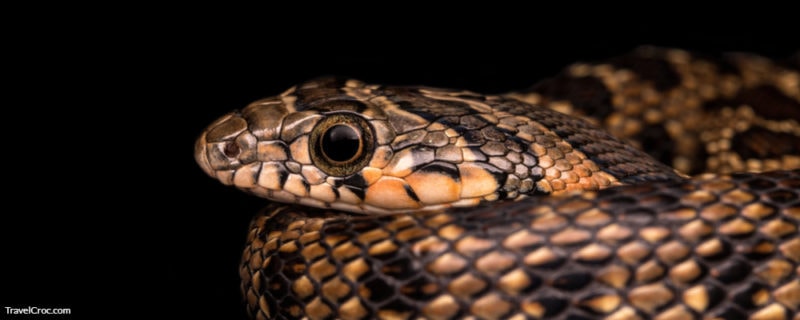
Hemorrhois hippocrepis
Its skin is dark brown or grey, with a chain pattern along its back. The stomach is pale.
Horseshoe whip snake lives in North Africa, southern and central Portugal, eastern, southern, and central Spain and Gibraltar.
Their preferred habitats are coastal plains with some low vegetation, dry mountains covered in scrub, orchards, cultivated areas, buildings or ruins.
These snakes feed on small mammals such as rats, occasional lizards and small birds.
Viperine Water Snake (Natrix maura)
Viperine water snake is a nonvenomous, fish-eating semiaquatic snake on average 85 cm (33 inches) long. They are not aggressive and will very rarely bite.
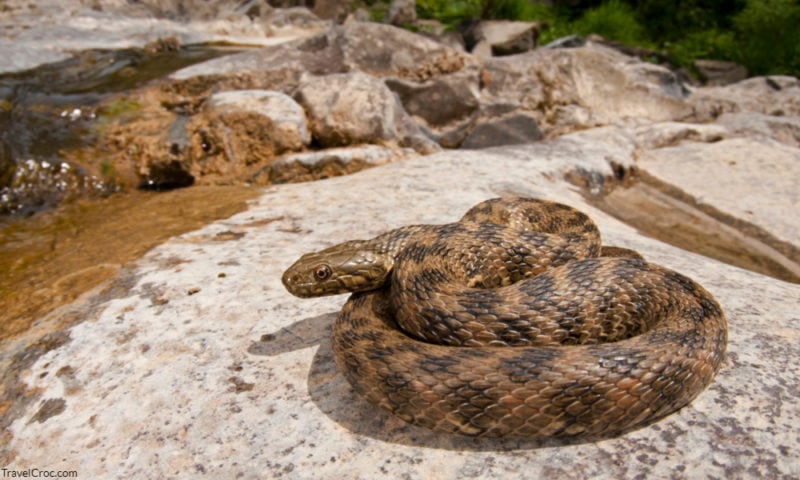
Natrix maura (viperine snake) in its habitat
Most time they spend in water hunting frogs, fish, and other aquatic creatures. They live in lakes, rivers and sometimes in brackish waters.
These snakes can be found in Portugal, Spain, France, northwest Italy, and are now found in many other European countries. They also live in North Africa.
Viperine water snakes can be brown, grey or reddish, with a black zigzag stripe, with yellow or red stomach, checkered with black, or completely black.
Recommended reading: Best time to visit Switzerland | Complete Guide
Ladder Snake (Zamenis scalaris)
The ladder snake is a non-venomous medium size snake endemic to southwestern Europe. It can be found all over Spain.
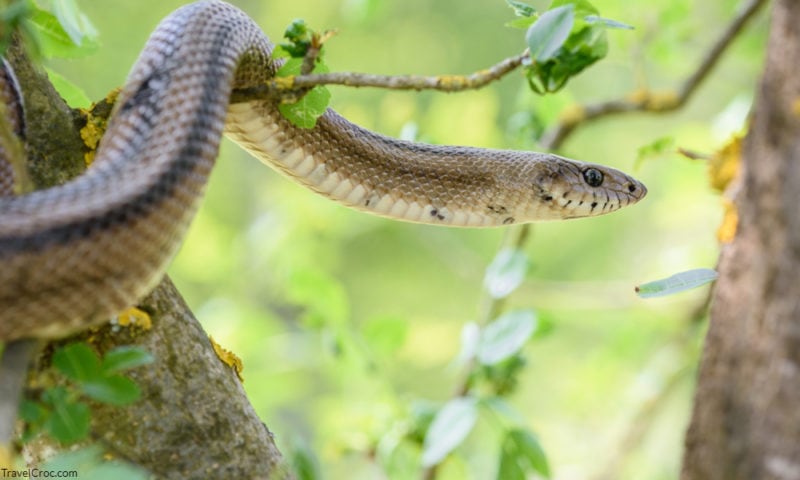
Ladder snake (Zamenis scalaris) in tree
The ladder snake reaches a maximum length of about 160 cm (63 in). It has a distinctive pointed snout. Its basic color ranges from yellow to dark brown. It has two darker stripes along the length of its body.
The Ladder Snake likes bushy cover, including vineyards, orchards, hedges and stone walls.
It feeds on mammals such as rabbits, mice, and shrews, but will also eat spiders, insects such as grasshoppers and birds. To catch birds and find active nests, the ladder snake climbs trees or man-made buildings.
If it is threatened, the ladder snake will hiss and lung forward with an open mouth. Do not try to pick it up or it will bite you and poop on you. And the smell is really bad.
Aesculapian Snake (Zamenis longissimus)
The Aesculapian snake is a nonvenomous snake native to Europe. It grows up to 160 cm (63 in) long. This snake is one of the largest snakes in Europe. It is long, dark, slender, and usually bronze color. Smooth scales give it a slightly metallic sheen.
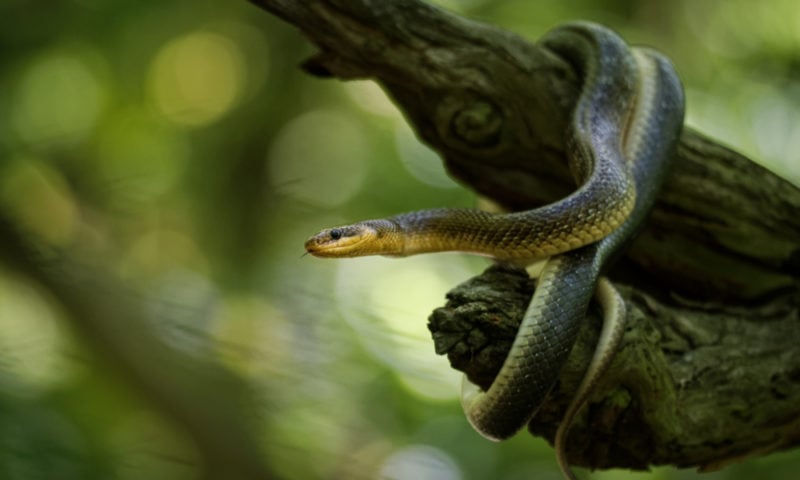
Aesculapian Snake – Zamenis longissimus, previously Elaphe longissima, nonvenomous olive green and yellow snake native to Europe, Colubrinae subfamily of the family Colubridae.
The Aesculapian snake lives in a forested, warm but not too hot environment. It should be fairly humid but not wet. It also likes rocky and hilly areas that are fairly isolated and have enough vegetation.
They do not avoid humans and can often be seen in gardens and sheds.
This snake feeds on rodents the size of a rat and other small mammals like moles and shrews. They are very good climbers and will go for birds and nests.
If cornered, they might try to intimidate their opponent by moving their mouth like they are chewing. Will bite if threatened.
Southern Smooth Snake (Coronella girondica)
Southern Smooth Snake is a non-venomous snake endemic to the countries of southern Europe and northern Africa.
It is a slim, elegant snake up to 60 cm in length) with a small, flat head, rounded body and a slightly marked neck. It is active between March and November. They are pretty slow and not good climbers.
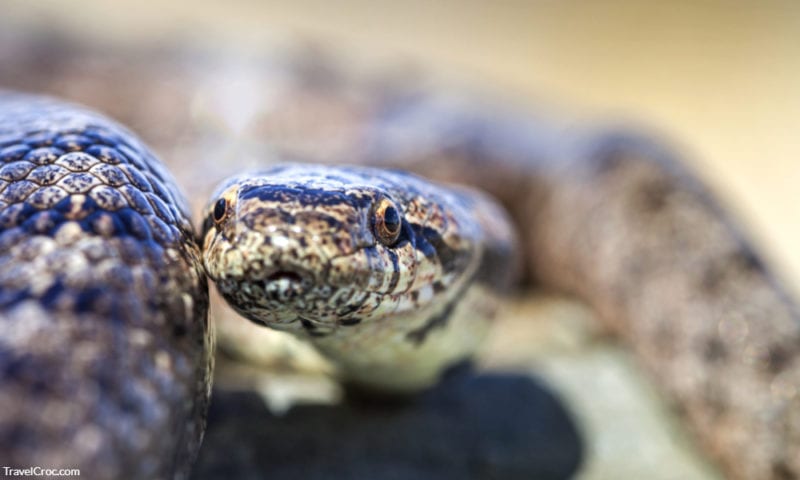
Southern smooth snake (Coronella girondica).
The snake has a dark line from the neck to the corner of the eye. The eye has a reddish ring around a black pupil. Its color varies between grey and brown to ochre. It has darker bands or spots across the back. The stomach is creamy or yellowish with a random pattern of dark scales.
Southern smooth snakes live in open scrub lands, rocky hillsides, open woods, hedgerows and around older trees. Southern Smooth Snake hide in old leaves and branches, in stone walls and under rocks. These snakes are mostly active in the evenings and at night and they are very elusive.
The Southern smooth snakes feed on small lizards such as skinks and geckos, smaller snakes and at times small mammals. They kill their prey by constricting them.
Western or Green Whip Snake (Hierophis viridiflavus)
The Green whip snake is a non-venomous slender snake with a small, well-defined head, smooth scales and very prominent eyes with round pupils.
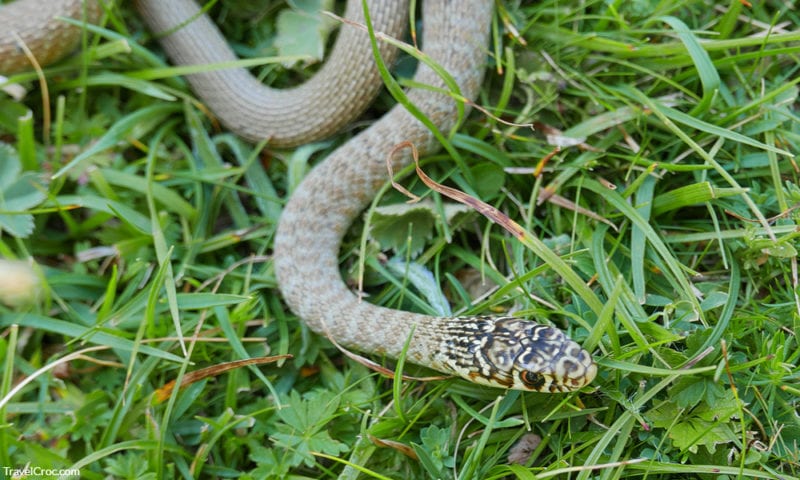
Closeup photography of the snake Hierophis viridiflavus, the green whip snake or western whip snake ,pyrenees catalonia Spain.
Its preferred habitats are temperate forests and shrubland, typical Mediterranean vegetation, pastureland, rural gardens, plantations, and urban areas
These snakes feed on lizards, frogs, mice, small birds and bird eggs. They are very active and will bite furiously if cornered. They hibernate in winter
Grass Snake (Natrix natrix)
Grass Snake, also called the water snake or ringed snake, is a non-venomous snake. It is frequently found near bodies of water. It feeds on amphibians.
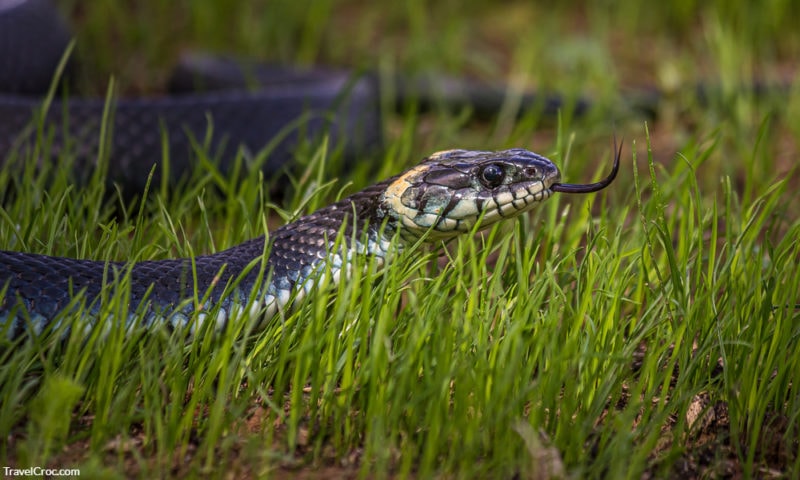
A non-venomous snake crawls in low green grass , sticking out its forked tongue. It’s Natrix natrix (grass, ringed or water snake). It’s often found near water and feeds on amphibians.
This snake is usually brown or dark green with a distinct yellow or white collar, which gave them the name ringed snake. Their color ranges from grey to totally black. They are darker in colder regions.
The grass snake lives all over mainland Europe, from Scandinavia to south Italy. It is also common in northwestern Africa and the Middle East.
Grass snakes mostly feed on amphibians such as toads and frogs, but will also eat ants and larvae.
Grass snakes are good swimmers and are found near freshwater, although they do not need water during the entire season. They like open woodland, woodland borders and field margins.If cornered, they can appear aggressive, hissing and striking without opening their mouth. They rarely bite.
What to do if you encounter a snake in Spain?
If you enconter a snake in Spain while hiking or camping, it’s important to stay calm and assess the situation. The safest option is to walk away from the snake if it is right in front of you. If a person gets bitten by a snake, then call the ambulance straight away. Try to take a photo of the snake (if possible), so medical staff can determine if the snake was venomous or not.
It is important to limit movements to stop the venom from spreading. Body weight makes difference too, the venom will have a stronger effect on lighter people such as kids.
Spain emergency number is 112. Ambulance services number is 061. Check out these 5 clear steps if you want more tips on what to do in this situation.
Conclusion
Although there are some really poisonous snakes in Spain, your chance of encountering them is very slim. In general, only a few snake bites are reported each year in Spain.
But, if you plan on going hiking or camping, it is good to know what to look for or better what to stay away from. If you get bitten, make sure you get a photo of the snake before looking for a doctor, so that the doctor would know what anti-venom to administer.


